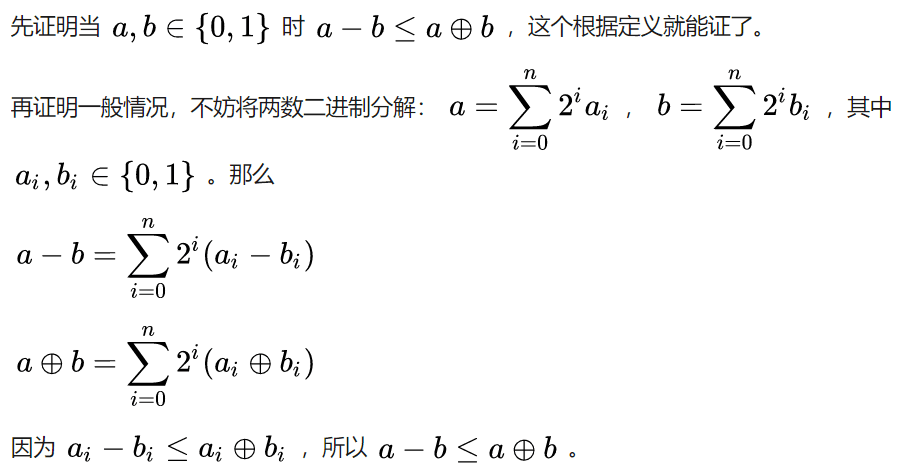链接:
https://uva.onlinejudge.org/index.php?option=com_onlinejudge&Itemid=8&page=show_problem&problem=4454
题意:
输入整数n(1≤n≤30000000),有多少对整数(a,b)满足:1≤b≤a≤n,且gcd(a,b)=a xor b。
例如n=7时,有4对:(3,2), (5,4), (6,4), (7,6)。
分析:
若a xor b = c,则a xor c = b,所以可以枚举a和c,然后算出b=a xor c,最后验证一下是否有gcd(a,b)=c。
时间复杂度如何?因为c是a的约数,所以和素数筛法类似,时间复杂度为n/1+n/2+…+n/n=O(nlogn)。
再加上gcd的时间复杂度为O(logn),所以总的时间复杂度为O(n(logn)(logn))。
上述程序写出来之后,可以打印一些满足gcd(a,b)=a xor b=c的三元组(a,b,c),然后很容易发现:c=a-b。
有了这个结论,还是沿用上述算法,枚举a和c,计算b=a-c,则gcd(a,b)=gcd(a,a-c)=c,
因此只需验证是否有c = a xor b,时间复杂度降为了O(nlogn)。
c=a-b的证明如下(其中⊕代表异或):
① c=a⊕b
② a-b≤a⊕b
③ a-b≥c
由①②③得:a-b≥c且a-b≤c,所以a-b=c。
证明②:

证明③:
因为c=gcd(a,b)且a>b,所以a/c-b/c≥1,即a-b≥c,证毕。
代码:
1 import java.io.*; 2 import java.util.*; 3 4 public class Main { 5 static final int UP = 30000000 + 1; 6 static int sum[] = new int[UP]; 7 8 static void constant() { 9 for(int c = 1; c < UP; c++) { 10 for(int a = c + c; a < UP; a += c) { 11 int b = a - c; 12 if((a ^ b) == c) sum[a]++; 13 } 14 } 15 for(int i = 1; i < UP; i++) sum[i] += sum[i-1]; 16 } 17 18 public static void main(String args[]) { 19 Scanner cin = new Scanner(new BufferedInputStream(System.in)); 20 constant(); 21 22 int T = cin.nextInt(); 23 for(int cases = 1; cases <= T; cases++) { 24 int n = cin.nextInt(); 25 System.out.printf("Case %d: %d ", cases, sum[n]); 26 } 27 cin.close(); 28 } 29 }